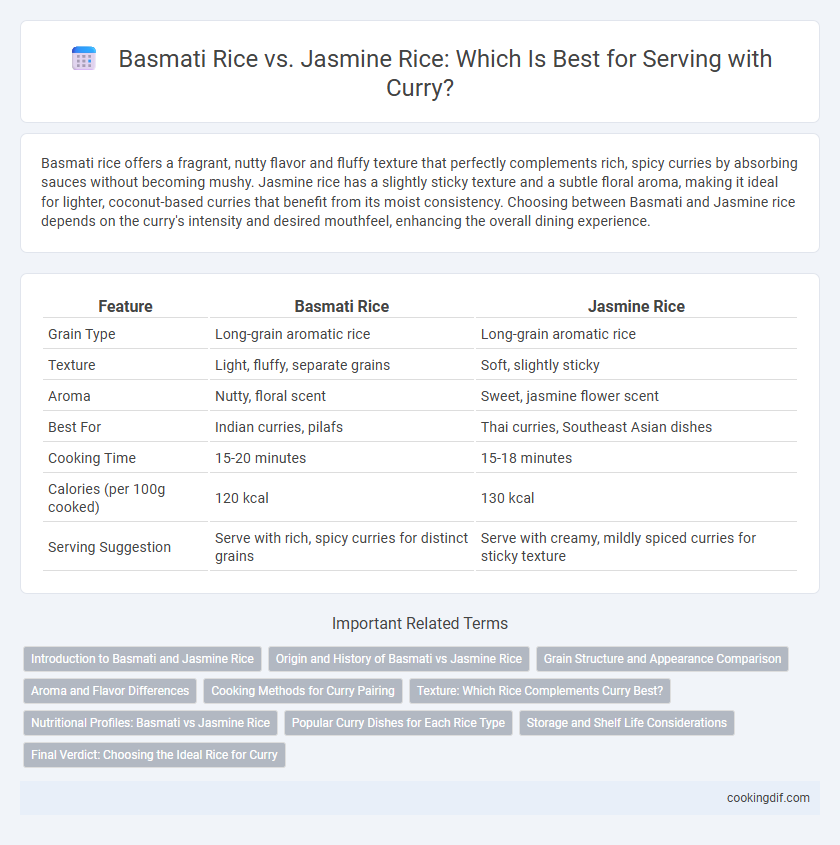Basmati rice offers a fragrant, nutty flavor and fluffy texture that perfectly complements rich, spicy curries by absorbing sauces without becoming mushy. Jasmine rice has a slightly sticky texture and a subtle floral aroma, making it ideal for lighter, coconut-based curries that benefit from its moist consistency. Choosing between Basmati and Jasmine rice depends on the curry's intensity and desired mouthfeel, enhancing the overall dining experience.
Table of Comparison
| Feature | Basmati Rice | Jasmine Rice |
|---|---|---|
| Grain Type | Long-grain aromatic rice | Long-grain aromatic rice |
| Texture | Light, fluffy, separate grains | Soft, slightly sticky |
| Aroma | Nutty, floral scent | Sweet, jasmine flower scent |
| Best For | Indian curries, pilafs | Thai curries, Southeast Asian dishes |
| Cooking Time | 15-20 minutes | 15-18 minutes |
| Calories (per 100g cooked) | 120 kcal | 130 kcal |
| Serving Suggestion | Serve with rich, spicy curries for distinct grains | Serve with creamy, mildly spiced curries for sticky texture |
Introduction to Basmati and Jasmine Rice
Basmati rice, primarily grown in the Indian subcontinent, is renowned for its long grains and distinct aromatic flavor, making it a traditional choice for serving with curry dishes. Jasmine rice, native to Thailand, features shorter grains with a soft, slightly sticky texture and a floral fragrance that complements Southeast Asian curries. Both varieties enhance curry meals uniquely, with Basmati offering a drier, fluffy consistency and Jasmine providing a moist, tender bite.
Origin and History of Basmati vs Jasmine Rice
Basmati rice, originating from the Indian subcontinent, is renowned for its distinctive fragrance and long grains, with a cultivation history dating back over a thousand years in the Himalayan foothills. Jasmine rice, native to Thailand, is characterized by its soft texture and subtly sweet aroma, cultivated predominantly in Southeast Asia for several centuries. Both varieties hold cultural significance and are traditionally paired with various curry dishes reflecting their regional culinary heritage.
Grain Structure and Appearance Comparison
Basmati rice features long, slender grains with a firm, fluffy texture that remains separate when cooked, making it ideal for absorbent curry dishes. Jasmine rice has shorter, plumper grains with a soft, slightly sticky texture and a naturally aromatic fragrance, complementing creamy or saucy curries. The visual contrast between basmati's distinct grains and jasmine's moist clumps influences presentation and mouthfeel in curry servings.
Aroma and Flavor Differences
Basmati rice offers a distinctive nutty aroma and a delicate, fluffy texture that absorbs curry flavors without overpowering them, making it ideal for rich Indian curries. Jasmine rice features a naturally sweet, floral fragrance with a soft, slightly sticky consistency, complementing Thai and Southeast Asian curry dishes by enhancing their fragrant spices. The choice between basmati and jasmine rice hinges on balancing aromatic intensity and texture to best match the curry's flavor profile.
Cooking Methods for Curry Pairing
Basmati rice, with its long, slender grains and aromatic flavor, is ideal for absorbing rich curry sauces due to its fluffy texture achieved through steaming or boiling without stirring. Jasmine rice, characterized by its slightly sticky and soft consistency from steaming, complements creamy or thicker curries by retaining moisture and creating a cohesive mouthfeel. Selecting the appropriate cooking method enhances the balance between the rice's texture and the curry's flavor profile, optimizing the dining experience.
Texture: Which Rice Complements Curry Best?
Basmati rice offers a long-grain, fluffy texture with individual grains that remain separate, making it ideal for soaking up curry sauces without becoming mushy. Jasmine rice features a softer, stickier texture with a subtle floral aroma that enhances the sensory experience of richer, creamier curries. For lighter, spiced curries, basmati rice complements best, while jasmine rice suits thicker, coconut-based or Thai-style curries.
Nutritional Profiles: Basmati vs Jasmine Rice
Basmati rice contains a lower glycemic index of approximately 50-58, making it a better option for blood sugar control compared to jasmine rice, which ranges from 68-80. Both varieties provide similar calorie counts--about 190 calories per cooked cup--but basmati rice offers higher fiber content, around 2 grams versus jasmine's 1 gram. Basmati rice also contains slightly more protein, enhancing its nutritional value alongside essential minerals like magnesium and phosphorus.
Popular Curry Dishes for Each Rice Type
Basmati rice pairs exceptionally well with Indian curries like Butter Chicken and Dal Makhani due to its long, fluffy grains that absorb rich, spiced gravies without becoming mushy. Jasmine rice complements Thai curries such as Green Curry and Massaman Curry, offering a slightly sticky texture and fragrant aroma that balances creamy coconut milk-based sauces. Selecting the right rice enhances the overall dining experience by matching the rice's texture and aroma with the curry's regional flavor profile.
Storage and Shelf Life Considerations
Basmati rice, with its lower moisture content and longer grain, typically offers a longer shelf life of up to 1-2 years when stored in a cool, dry place, making it ideal for long-term storage. Jasmine rice, known for its fragrant aroma and softer texture, generally has a shorter shelf life of about 6-8 months due to its higher moisture content and delicate grains. Proper airtight containers and refrigeration can extend the freshness of both basmati and jasmine rice but basmati remains more resilient for extended storage in curry preparation.
Final Verdict: Choosing the Ideal Rice for Curry
Basmati rice's long, separate grains and nutty aroma perfectly complement rich, spiced curries by absorbing flavors without becoming mushy, making it ideal for Indian-style dishes. Jasmine rice offers a sticky texture and floral fragrance that pairs well with Southeast Asian curries, providing a slightly sweeter flavor profile. For an authentic curry experience, select basmati rice with its distinct grain structure for bold, aromatic curries or jasmine rice for creamy, coconut-infused curries.
Basmati rice vs jasmine rice for serving Infographic

 cookingdif.com
cookingdif.com